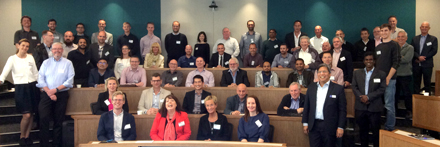
On Thursday 13 September Forest & Wood Products Australia in conjunction with ARC and Future TimberHub held a one day event focusing on Next Generation Timber Products and Systems in Melbourne which attracted overseas and Australian presenters. Source: Timberbiz
The seminar and workshop topics all revolved around Australia’s R&D capacity to consider future market opportunities, assess risks and threats, and address possible solutions.
Australian research groups were well represented with Dilum Fernandes and Joe Gattas from the University of Queensland discussing work on the Industrial Transformation Research Hub to Transform Future Tall Timber Buildings (Future Tall Timber Hub) and Priyan Mendis and Tuan Ngo from the University of Melbourne on the ARC Training Centre for Advanced Manufacturing of Prefabricated Housing.
It was Greg Nolan from the ARC Centre for Forest Value (CFV) at the University of Tasmania, who presented via video link, who stole the show with a broad discussion of the wood products industry and where it is heading. He detailed the CFV’s activities and importantly discussed the possibility of manufacturing CLT from plantation hardwood. Visiting scholar Maya Pangh, who is currently working with CFV, is experimenting with making hardwood CLT from fibre managed E.nitens and E.globulus boards.
Another interesting presentation came all the way from Sweden and it was a huge delegation from ProWOOD which in itself consist for 10 companies, 10 doctoral students, two universities, one industrial development centre, six professors, 14 senior researchers and 15 industrial mentors. Not all of these attended however, 13 presentations were forthcoming.
Quite surprisingly, despite the large number of presenters, they stuck well to their schedule while providing information and background on ProWOOD, Swedish forestry and the numerous research projects.
One of the standouts was Steffen Landscheidt’s Robotic Automation in Swedish Wood Product Industries presentation. Robotic applications in wood product manufacture has to be a goal for the industry in order to increase competitiveness and improve the manufacturing process.
His research will map requirements, prerequisites and obstructions to the processes from the perspective of robot manufacturers and system integrators. He also aims to develop methods and strategies for the implementation of industrial robots into the wood working sector and to develop solutions for standardized and flexible industrial robotic cells for timber house construction, wood furniture and joinery.
Future issues of Australasian Timber Magazine and Australian Forests & Timber News will contain feature stories on several of the presentations at this event.





